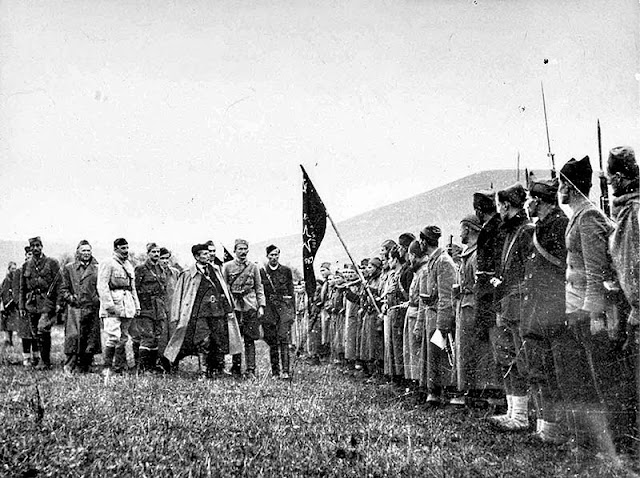The First Proletarian Shock Brigades
 |
| Supreme Commander Tito inspects the First Proletarian Brigade |
The first Proletarian shock Brigade was the first partisan brigades in occupied Yugoslavia. During the war, the brigade was considered an elite unit of the National Liberation Army of Yugoslavia.
It was formed on 21 December 1941 in Rudo, of the Partisan rebels, after the withdrawal of the Sandzak. The decision on the formation of the First Proletarian Brigade made the Central Committee of the Communist Party. On the day of the formation had six battalions (four from Serbia and two from Montenegro) the total strength of 1,200 soldiers. The first commander of the brigade was Koca Popovic, a political commissar Filip Kljajic Fica.
 |
| Koca Popovic, commander of the First Proletarian Brigade. |
The First Proletarian Shock Brigade in the 1240 war days had 530 large and small battle, it is almost every other day was spent in the fight. Other days were mostly spent in exhausting marches.
The First Proletarian Brigade on its war path traveled more than 20,000 kilometers. In the battles fought more than 22,000 people from all over Yugoslavia. She had more than 7,500 killed, wounded and missing soldiers. The brigade has given more than 3,000 executives and 83 national heroes.
First Proletarian Brigade was awarded the Medal of National Liberation, the Medal of the Partisan Star, Medal of Brotherhood and Unity and the Medal Merit for the People. On the occasion of the fifteenth battle of Sutjeska, in June 1958, the Brigade was awarded the Medal of National Hero.
 |
| The Brigada at one of the many marches |
Battle way of The first proletarian shock brigades
At the end of December 1941, First Proletarian Brigade, together with the Supreme Headquarters, passed in eastern Bosnia. During the second enemy offensive, from 17 to 23 January 1942 led many battles: Rogatica, Vares, Han Pijesak and Bijele Voda. The bulk of the brigade has carried out a march over Mount Igman, at a temperature of -32 degrees. After completion of the other offensive again take significant ventures in eastern Bosnia.
 |
| The First Proletarian Brigade in Belgrade in October in 1944. |
During the third enemy offensive along with the Second Proletarian Brigade operated in eastern Bosnia, Montenegro, Herzegovina and in heavy fighting (Polje Kolašinska, Durmitor, Herzegovina) significantly helped the successful withdrawal of partisan forces in the area Tromeđe.
In the Fourth enemy offensive, in the six-day march, the Brigade moved from the sector Banja Luka, over Šipraga, Zbojská, Gornji Vakuf, on the railway line Sarajevo-Mostar. However, on the night of 17/18. February liquidate enemy crew on the section Raštelica-Brđani and subsequently heavy fighting on the Ivansedlo-Bradina and part of the forces involved in the attack on Konjic. The brigade took part in the famous Partisan forces counterattack at Gornji Vakuf, from 3 to 5 March 1943, and then close the direction of Gornji Vakuf-Prozor.
 |
| Supreme Commander Tito handing war flag to the battalions of the First Proletarian Brigade in Foca, 15 April 1942. |
After forcing the Neretva in progress The Main Operating groups to the east, the brigade first progress the general direction: Glatičevo, Kalinovik area, Ustikolina. From 15 to March 17 brigade smashed Chetnik forces at Glavatičevo and Lipeta on the mountain, and on the night of 22/23. March was led by heavy fighting with the Chetniks near Kalinovik. In these battles the Chetniks suffered several heavy defeats, a brigade, was praised by the Supreme Command.
 |
| The fighters of the 4. kraljevačkog Battalion of the First Proletarian Brigade on the road Foca - Gorazde, on 1 May 1942. |
In the battle of Sutjeska The first proletarian lead the fight against the First German mountain division on the sector Bijelo Polje, Mojkovac, Šahovići. From this sector was transferred to the sector Čelebića, for the protection of the Central Hospital and closing direction of Foca-Čelebić. After a seven-day march, 21 May at Čelebića from movement attacked and smashed 13th Home Guard regiments. From then until 24 May at the sector, together with other units, led a bitter struggle. She participated in the 24th and 25th May in a failed attempt to break through southeast of Foca. By June 6, led the fight in the valley of Sutjeska, and on June 8, broke out on Zelengora. On June 10, in the early morning near the village Balinovac brigade overran the battle group Höhne:
 |
| The flag and the Medal of National Hero of the First Proletarian Brigade at the Military Museum in Belgrade |
In the winter of 1943/44. and in the spring of 1944, acts around Jajce, Mrkonjic Grad. In the Drvar operation leads a fierce battle in the direction of Mrkonjic Grad-Mlinište and Mlinište-Glamoc. From western Bosnia moves for Sandzak, and along the way she led the fight on the mountains Vranica, Zec, Bitovnja and near Trnovo. In the August 1944 The Brigade participated in the battles in Sandzak, and on 23 August started breakthrough in Serbia.
 |
| The nurses on the 1st Proletarian Brigade in Belgrade, October in 1944. |
The first Proletarian heavy fighting with the Bulgarian forces in Palisade and with strong Chetnik forces on Jelova gora, at Karan, Kosjeric, and Varde, for the liberation of Bajina Basta and Valjevo (September) and Ub (October). In the Belgrade, operation highlighted in many battles. From December 1944 to April 1945, operates on the Srem front. Participates in the breakthrough of Srem front on 12 April 1945 and participates in more enterprise in Srem, Slavonia and all the way to Zagreb. The last fight led to the liberation of Zagreb, in which enters on 9 May 1945.






Comments
Post a Comment